How It All Began, Part Three
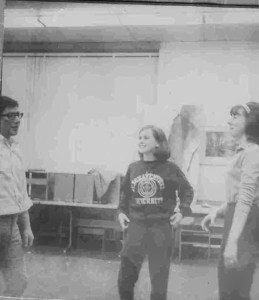
Before I was a writer, I was a dancer. This was at rehearsal in the art room for a number in The Music Man
Kaitlyn Dunnett/Kathy Lynn Emerson here. My original plan was to tell you “How It All Began” with the early equivalent of blogging. That would be journals written in the form of letters to imaginary friends. The first was named Estelle, the second was Mara. Before the first of the journals, I had fat little daily diary books with dinky locks. To be honest, I mostly pasted in clippings from TV Guide to record what shows I watched.
It was sometime in high school that I switched to writing journal entries and I gave those up when I started college. When I was in my twenties, I destroyed all of the old diaries except for seventeen pages from the journal written during my senior year. I wish now that I’d kept the journals, or at least a few more pages from that one. And I wish I still had the essay I wrote for English class about the events that are on those pages, the one the teacher told me was “too personal to grade.” Why? Because those accounts literally spawned one of my earliest novels.
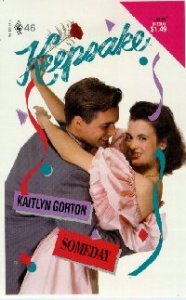
original 1988 cover
Just as well it wasn’t published since there’s no prom scene in the novel!
Way back in 1987, I sold a YA romance titled The Missing Bagpipe to an imprint of Silhouette Books. The editor who bought it, Carolyn Marino, liked my writing and asked for more, so I immediately started work on an idea I’d first had back in 1982—to use some of my own high school experiences in a novel. That book, Someday, just about wrote itself, especially when I incorporated a couple of short stories I’d already written, ones no children’s magazine had wanted to buy. I finished the manuscript in two months, sent it in, and Carolyn bought it as soon as she read it. It was scheduled for December 1988. Just before that, after I’d seen page proofs and had been sent a few copies of the cover flat, Silhouette discontinued the entire line. By then Carolyn had also bought rights to a sequel to The Missing Bagpipe. Yes, that’s right. All three were cancelled. Fortunately I got the rights back, and kept the advances, but it was still a big disappointment.
To make a long story short, The Missing Bagpipe resold to Avon Camelot for middle-grades readers as The Mystery of the Missing Bagpipes, the sequel was revamped into an adult category romance, and Someday took a long, winding road, with many revisions, until I finally published it myself. Today’s Someday is definitely not an autobiography. Believe me, I never had two guys vying for my attention, and the “Project Graduation” movement didn’t exist back in 1965. But there are a lot of moments that come directly from my life, starting with the first line of the novel:
“Someday, Kristy, if you stay as sweet and innocent as you are now, you’re going to make some lucky guy a great wife.”
That’s what the boy Kristy Russell is crazy about tells her, and that’s what I boy I had a crush on said to me when I gathered up all my courage and asked him to be my date for graduation night. In the novel, written for ages twelve and up, sixteen-year-old Kristy reacts as I did—the last thing she wants is to be thought “sweet and innocent.” Unlike me, she embarks on a journey of self-discovery, trying to figure out why he rejected her. In the attempt, she comes to realize that her own self-esteem is more important than what anyone else thinks of her and that knowledge enables her to make the right choice when she is faced with a potentially life-altering decision.
The pages recounting that painful experience with rejection are long gone from my journal, but the ones from May 14-17, 1965, during and just after our high school production of The Music Man, for which I was choreographer yielded lots of details to augment what I could remember of the experience. My fictional Kristy is the choreographer for the same show, but although I used some bits and pieces, her relationships and how she deals with them are very different from mine. She has to choose between two boyfriends. I was a late bloomer in that area. Kristy has to deal with a “mean girl” but instead of putting up with her taunts, as I did, she resolves the situation by discovering what is behind the other girl’s animosity.
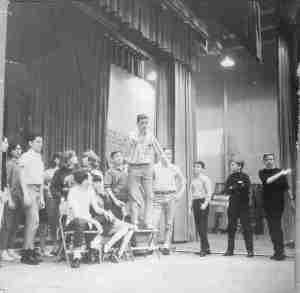
rehearsal, 1965
Anyone who was in our 1965 production will probably recognize a few incidents, from mishaps during the two performances, to a prank some of us played on an unpopular teacher after a rehearsal, to the way we socialized with and idolized the teacher who directed the production.
One thing I couldn’t use was our after-party, since a group of us celebrated at a nightspot in a nearby town. Although the drinking age at that time in New York State was eighteen, I was still underage, as were some of the others who managed to avoid being carded. By the time I started to write Someday, attitudes on alcohol at teen parties, even among teens, had undergone considerable change.
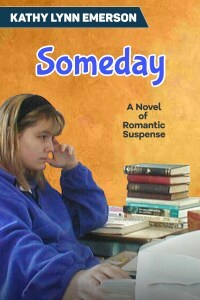 For the final revision, the one now available in paperback and e-book formats, I moved the story to Maine in 1992. My niece, who posed for the cover, gave me insight into both the differences and the similarities in our high school experiences. She found a reassuring number of similarities—human nature, after all, doesn’t change a whole lot.
For the final revision, the one now available in paperback and e-book formats, I moved the story to Maine in 1992. My niece, who posed for the cover, gave me insight into both the differences and the similarities in our high school experiences. She found a reassuring number of similarities—human nature, after all, doesn’t change a whole lot.
I intended to reproduce several pages from my journal here, but when I reread them I discovered two things. First, most were written in the wee hours of the morning after each of the two shows. Can you say “stream-of-consciousness?” I jumped around a lot, referred to people by initials and nicknames (almost sixty years later, I have no idea who some of them are) and overused expressions like “Too funny!” Second, I included confidences from girls I was particular friends with in the cast and crew. Even all these years later, I’d feel guilty if I revealed them. So, you only get to see one page. If nothing else, reading it should prove that my ability to write an essay has improved considerably in six decades.
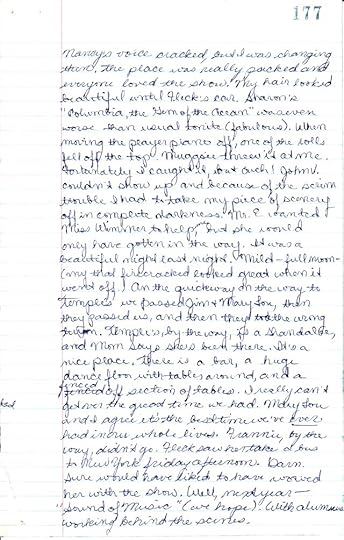
Kathy Lynn Emerson/Kaitlyn Dunnett has had sixty-four books traditionally published and has self published others. She won the Agatha Award and was an Anthony and Macavity finalist for best mystery nonfiction of 2008 for How to Write Killer Historical Mysteries and was an Agatha Award finalist in 2015 in the best mystery short story category. In 2023 she won the Lea Wait Award for “excellence and achievement” from the Maine Writers and Publishers Alliance. She was the Malice Domestic Guest of Honor in 2014. She is currently working on creating new editions of her backlist titles. Her website is www.KathyLynnEmerson.com.
Lea Wait's Blog
- Lea Wait's profile
- 506 followers



